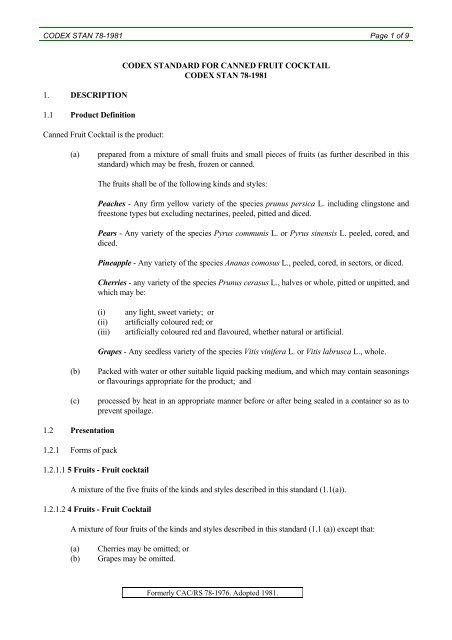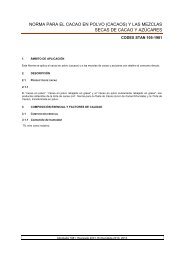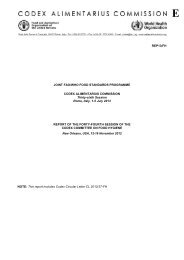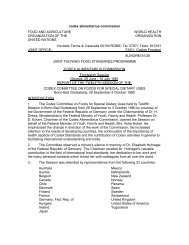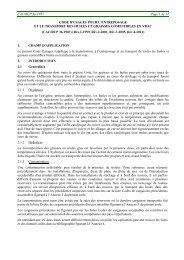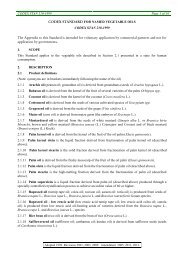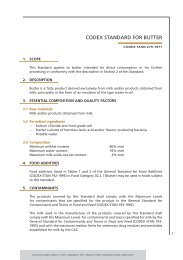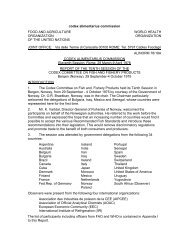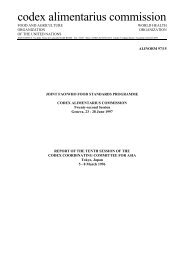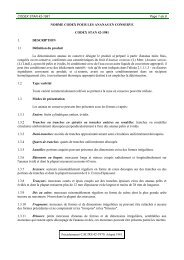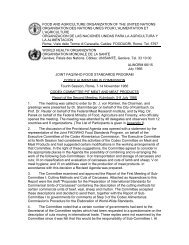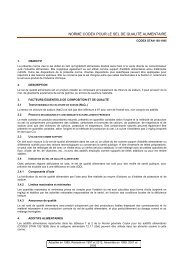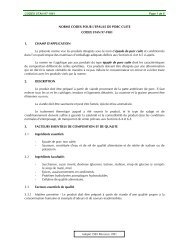CODEX STANDARD FOR CANNED FRUIT Cocktail Codex STAN ...
CODEX STANDARD FOR CANNED FRUIT Cocktail Codex STAN ...
CODEX STANDARD FOR CANNED FRUIT Cocktail Codex STAN ...
You also want an ePaper? Increase the reach of your titles
YUMPU automatically turns print PDFs into web optimized ePapers that Google loves.
<strong>CODEX</strong> <strong>STAN</strong> 78-1981 Page 1 of 9<br />
1. DESCRIPTION<br />
1.1 Product Definition<br />
Canned Fruit <strong>Cocktail</strong> is the product:<br />
<strong>CODEX</strong> <strong><strong>STAN</strong>DARD</strong> <strong>FOR</strong> <strong>CANNED</strong> <strong>FRUIT</strong> COCKTAIL<br />
<strong>CODEX</strong> <strong>STAN</strong> 78-1981<br />
(a) prepared from a mixture of small fruits and small pieces of fruits (as further described in this<br />
standard) which may be fresh, frozen or canned.<br />
The fruits shall be of the following kinds and styles:<br />
Peaches - Any firm yellow variety of the species prunus persica L. including clingstone and<br />
freestone types but excluding nectarines, peeled, pitted and diced.<br />
Pears - Any variety of the species Pyrus communis L. or Pyrus sinensis L. peeled, cored, and<br />
diced.<br />
Pineapple - Any variety of the species Ananas comosus L., peeled, cored, in sectors, or diced.<br />
Cherries - any variety of the species Prunus cerasus L., halves or whole, pitted or unpitted, and<br />
which may be:<br />
(i) any light, sweet variety; or<br />
(ii) artificially coloured red; or<br />
(iii) artificially coloured red and flavoured, whether natural or artificial.<br />
Grapes - Any seedless variety of the species Vitis vinifera L. or Vitis labrusca L., whole.<br />
(b) Packed with water or other suitable liquid packing medium, and which may contain seasonings<br />
or flavourings appropriate for the product; and<br />
(c) processed by heat in an appropriate manner before or after being sealed in a container so as to<br />
prevent spoilage.<br />
1.2 Presentation<br />
1.2.1 Forms of pack<br />
1.2.1.1 5 Fruits - Fruit cocktail<br />
A mixture of the five fruits of the kinds and styles described in this standard (1.1(a)).<br />
1.2.1.2 4 Fruits - Fruit <strong>Cocktail</strong><br />
A mixture of four fruits of the kinds and styles described in this standard (1.1 (a)) except that:<br />
(a) Cherries may be omitted; or<br />
(b) Grapes may be omitted.<br />
Formerly CAC/RS 78-1976. Adopted 1981.
<strong>CODEX</strong> <strong>STAN</strong> 78-1981 Page 2 of 9<br />
1.2.2 Forms of Packing Media 1<br />
Canned Fruit <strong>Cocktail</strong> may be packed in any one of the following packing media with or without sugars<br />
and/or optional ingredients:<br />
(a) Water - in which water is the sole liquid packing medium.<br />
(b) Water and Fruit Juice - in which water and fruit juice(s) from the specified fruits, which may<br />
be strained or filtered, is the sole liquid packing medium.<br />
(c) Fruit Juice - in which one or more fruit juice(s) from the specified fruits, which may be<br />
strained or filtered, is the sole liquid packing medium.<br />
2. ESSENTIAL COMPOSITION AND QUALITY FACTORS<br />
2.1 Composition<br />
2.1.1 Basic Ingredients<br />
- Fruit as defined in 1.1(a);<br />
- Water;<br />
- Fruit juice<br />
2.1.2 Other Ingredients<br />
- One or more of the following sugars: sucrose, invert sugar syrup, dextrose, glucose syrup, dried<br />
glucose syrup;<br />
- Spices;<br />
- Mint<br />
2.2 Formulation<br />
2.2.1 Fruit content<br />
2.2.1.1 Proportions of fruits<br />
The products shall contain fruits in the following proportions, based on the individual drained fruit<br />
weights in relation to the total drained weight of all the fruits:<br />
1 See Appendix to Part I.
<strong>CODEX</strong> <strong>STAN</strong> 78-1981 Page 3 of 9<br />
5 Fruits - Fruit <strong>Cocktail</strong> 4 Fruits - Fruit <strong>Cocktail</strong><br />
Peaches 30% to 50% 30% to 50%<br />
Pears 25% to 45% 25% to 45%<br />
Pineapple 6% to 16% 6% to 25%<br />
- and either -<br />
Grapes 6% to 20% 6% to 20%<br />
Cherries 2% to 6% 2% to 15%<br />
2.2.1.2 Compliance with fruit content requirements<br />
A lot will be considered as meeting the requirements for Proportions of fruits (2.2.1.1) when:<br />
(a) the average of the individual fruit proportions from all containers in the sample is within the<br />
range required for the individual fruits; and<br />
(b) the number of individual containers which are not within the range for any one or more fruits<br />
do not exceed the acceptance number (c) of an appropriate sampling plan with an AQL of 6.5<br />
(see relevant <strong>Codex</strong> texts on methods of analysis and sampling).<br />
2.2.2 Packing media<br />
2.2.2.1 Classification of packing media when sugars are added<br />
(a) When sugars are added to water or water and one or more fruit juices the liquid media shall be<br />
classified on the basis of the cut-out strength as follows:<br />
Basic Syrup Strengths<br />
Light Syrup - Not less than 14 o Brix<br />
Heavy Syrup - Not less than 18 o Brix<br />
Optional Packing Media<br />
When not prohibited in the country of sale, the following packing media may be used:<br />
Water Slightly Sweetened )<br />
Slightly Sweetened Water ) Not less than 10 o Brix but less than 14 o Brix<br />
Extra Light Syrup )<br />
Extra Heavy Syrup Not less than 22 o Brix<br />
(b) When sugars are added to fruit juice(s), the liquid media shall be not less than 14 o Brix and<br />
they are classified on the basis of the cut-out strength as follows:<br />
Lightly sweetened<br />
(name of fruits) juice - Not less than 14 o Brix<br />
Heavily sweetened<br />
(name of fruits) juice - Not less than 18 o Brix<br />
or
<strong>CODEX</strong> <strong>STAN</strong> 78-1981 Page 4 of 9<br />
2.2.2.2 Compliance with packing media classification<br />
Cut-out strength of sweetened juice of syrup is to be determined on sample average, but no container<br />
may have a Brix value lower than that of the minimum of the next category below, if such there be.<br />
2.3 Sizes and shapes of fruits<br />
2.3.1 Diced peaches, pears or pineapple<br />
75% or more of all such drained fruits are of approximate cube-shapes which:<br />
(a) are not over 20 mm in greatest edge dimension; and<br />
(b) will not pass through square meshes of 8 mm.<br />
2.3.2 Sectors of pineapple<br />
80% or more of all the drained pineapple portion approximate wedge-shapes of the following<br />
dimensions:<br />
(a) outside arc - 10 mm to 25 mm; and<br />
(b) thickness - 10 mm to 15 mm; and<br />
(c) radius (from inside to outside arc) - 20 mm to 40 mm.<br />
2.3.3 Whole grapes or cherries<br />
90% or more by count (based on sample average) of whole grapes, or of whole cherries, approximate<br />
normal shape except for proper preparation (such as removing pits or stems) and:<br />
(a) are not broken into two or more parts;<br />
(b) are not seriously crushed, mutilated, or torn.<br />
2.3.4 Halved cherries<br />
80% or more by count (based on sample average) of the cherry units are approximate halves which are<br />
not broken into two or more parts.<br />
2.4 Quality Criteria<br />
2.4.1 Colour - Canned Fruit <strong>Cocktail</strong> shall have normal colour except that a slight leaching of colour from<br />
the coloured cherries is acceptable.<br />
2.4.2 Flavour - Canned Fruit <strong>Cocktail</strong> shall have a normal flavour characteristic for each fruit and for the<br />
entire mixture.<br />
Canned Fruit <strong>Cocktail</strong> with special ingredients shall have the flavour characteristic of that imparted by<br />
the fruits in the product and the other substances used.<br />
2.4.3 Texture - The fruit ingredients shall not be excessively firm nor excessively soft, as is appropriate for<br />
the respective fruit.<br />
2.4.4 Defects and Allowances - Canned Fruit <strong>Cocktail</strong> shall be substanitally free from defects within the<br />
limits set forth as follows: (see relevant <strong>Codex</strong> texts on methods of analysis and sampling).
<strong>CODEX</strong> <strong>STAN</strong> 78-1981 Page 5 of 9<br />
(a) Blemished fruit pieces -<br />
(consisting of pieces of fruit with dark<br />
surface areas, spots penetrating the fruit,<br />
and other abnormalities)<br />
(b) Peel (based on averages)<br />
(considered a defect only when occurring<br />
on, or from, those fruits which are peeled)<br />
(c) Pit material (based on averages) -<br />
(consisting of pieces of pit or of fruit stones<br />
and hard and sharp pit points; very small<br />
pit fragments of less than 5 mm in greatest<br />
dimension which do not have sharp points<br />
or edges are disregarded)<br />
(d) Small stems (based on averages) -<br />
(such as capstems from grapes)<br />
(e) Large stems (based on averages) -<br />
(such as from peaches, pears, or cherrries)<br />
2.4.5 Classification of "defectives"<br />
Maximum Limits<br />
(based on the weight of drained fruit)<br />
20% m/m<br />
Total of all fruit units so affected<br />
25 cm 2<br />
aggregate area per kg<br />
1 piece, of any size per 2 kg<br />
5 per kg<br />
1 large stem, or piece thereof, per kg<br />
A container shall be considered a "defective" when it fails to meet one or more of:<br />
(1) the applicable requirements in 2.3.1 through 2.3.4 (except for style and shapes for grapes and<br />
cherries which are based on averages); and<br />
(2) the applicable quality requirements in 2.4.1 through 2.4.4 (except for peel, pit material, and<br />
stems which are based on averages).<br />
2.4.6 Lot Acceptance<br />
A lot will be considered as meeting the applicable quality and other requirements referred to in subsection<br />
2.4.5 when:<br />
(a) for those requirements which are not based on averages the number of "defectives", as defined<br />
in sub-section 2.4.5, does not exceed the acceptance number (c) of an appropriate sampling<br />
plan with an AQL of 6.5 (see relevant <strong>Codex</strong> texts on methods of analysis and sampling); and<br />
(b) the requirements which are based on sample average are complied with.
<strong>CODEX</strong> <strong>STAN</strong> 78-1981 Page 6 of 9<br />
3. FOOD ADDITIVES<br />
3.1 Colours<br />
Erythrosine (to colour cherries only when<br />
artificially coloured cherries are used)<br />
3.2 Flavours<br />
3.2.1 Natural fruit essence<br />
3.2.2 Natural flavours and their identical<br />
synthetic equivalents<br />
3.2.3 Cherry Laurel Oil (to flavour artificially<br />
coloured cherries only)<br />
3.2.4 Bitter Almond Oil<br />
(to flavour artificially coloured cherries<br />
only)<br />
3.3 Antioxidant<br />
L-ascorbic acid<br />
4. CONTAMINANTS<br />
Maximum Level<br />
Limited by Good Manufacturing Practice<br />
Limited by Good Manufacturing Practice<br />
Limited by Good Manufacturing Practice<br />
10 mg/kg in the total product<br />
40 mg/kg in the total product<br />
500 mg/kg<br />
Lead (Pb) 1 mg/kg<br />
Tin (Sn) 250 mg/kg calculated as Sn<br />
5. HYGIENE<br />
5.1 It is recommended that the product covered by the provisions of this standard be prepared and handled<br />
in accordance with the appropriate sections of the Recommended International Code of Practice - General<br />
Principles of Food Hygiene (CAC/RCP 1-1969), and other Codes of Practice recommended by the <strong>Codex</strong><br />
Alimentarius Commission which are relevant to this product.<br />
5.2 To the extent possible in Good Manufacturing Practice, the product shall be free from objectionable<br />
matter.<br />
5.3 When tested by appropriate methods of sampling and examination, the product:<br />
- shall be free from microorganisms in amounts which may represent a hazard to health;<br />
- shall be free from parasites which may represent a hazard to health; and<br />
- shall not contain any substance originating from microorganisms in amounts which may<br />
represent a hazard to health.
<strong>CODEX</strong> <strong>STAN</strong> 78-1981 Page 7 of 9<br />
6. WEIGHTS AND MEASURES<br />
6.1 Fill of container<br />
6.1.1 Minimum Fill<br />
The container shall be well filled with fruit and the product (including packing medium) shall occupy<br />
not less than 90% of the water capacity of the container. The water capacity of the container is the volume of<br />
distilled water at 20 o C which the sealed container will hold when completely filled.<br />
6.1.2 Classification of "Defectives"<br />
A container that fails to meet the requirement for minimum fill (90 percent container capacity) of 6.1.1<br />
shall be considered a "defective".<br />
6.1.3 Lot Acceptance<br />
A lot will be considered as meeting the requirement of 6.1.1 when the number of "defectives" does not<br />
exceed the acceptance number (c) of an appropriate sampling plan with an AQL of 6.5 (see relevant <strong>Codex</strong> texts<br />
on methods of analysis and sampling).<br />
6.1.4 Minimum Drained Weight<br />
6.1.4.1 The drained weight of the product shall be not less than 60% of the weight of distilled water at 20 o C<br />
which the sealed container will hold when completely filled.<br />
6.1.4.2 The requirement for minimum drained weight shall be deemed to be complied with when the average<br />
drained weight of all containers examined is not less than the minimum required, provided that there is no<br />
unreasonable shortage in individual containers.<br />
7. LABELLING<br />
In addition to the requirements of the General Standard for the Labelling of Prepackaged Foods<br />
(<strong>CODEX</strong> <strong>STAN</strong> 1985) the following specific provisions apply:<br />
7.1 The Name of the Food<br />
7.1.1 The name of the product shall be "Fruit <strong>Cocktail</strong>".<br />
7.1.2 The following, as applicable, shall be included as part of the name or in close proximity to the name,<br />
unless in the country where the product is sold a true pictorial representation of the product accompanied by a<br />
complete list of the fruits in the statement of ingredients would suffice in accordance with its national<br />
legislation:<br />
"5 Fruits" or "With Five Fruits";<br />
or<br />
"4 Fruits" or "With Four Fruits".<br />
7.1.3 When the packing medium is composed of water, or water and one or more fruit juices in which water<br />
predominates, the packing medium shall be declared as part of the name or in close proximity thereto as:<br />
"In water" or "Packed in water".<br />
7.1.4 When the packing medium is composed solely of a single fruit juice, the packing medium shall be
<strong>CODEX</strong> <strong>STAN</strong> 78-1981 Page 8 of 9<br />
declared as part of the name or in close proximity thereto as:<br />
"In (name of fruit) juice".<br />
7.1.5 When the packing medium is composed of two or more fruit juices, it shall be declared as part of the<br />
name or in close proximity thereto:<br />
"In (name of fruits) juice" or "In fruit juices" or "In mixed fruit juices".<br />
7.1.6 When sugars are added to water, or water and one or more fruit juices in which water predominates, the<br />
packing medium shall be declared as may be appropriate:<br />
- "Water slightly sweetened" or<br />
"Slightly sweetened water" or<br />
"Extra light syrup" or<br />
- "Light syrup" or<br />
- "Heavy syrup" or<br />
- "Extra heavy syrup".<br />
7.1.7 when the packing medium contains water and one or more fruit juice(s), in which the fruit juice<br />
comprises 50% or more by volume of the packing medium, the packing medium shall be designated to indicate<br />
the preponderance of such fruit juice, as for example:<br />
"In (name of fruits) juice(s) and water"<br />
7.1.8 When sugars are added to one or more fruit juices, the packing medium shall be declared as may be<br />
appropriate:<br />
"Lightly sweetened (name of fruit(s)) juice"<br />
or<br />
"Heavily sweetened (name of fruit(s)) juice"<br />
or<br />
"Lightly sweetened fruit juices"<br />
or<br />
"Lightly sweetened mixed fruit juices"<br />
or<br />
"Heavily sweetened fruit juice"<br />
or<br />
"Heavily sweetened mixed fruit juices"<br />
7.1.9 A declaration, as part of the name or in close proximity to the name, shall be made of any characteristic<br />
flavouring; e.g. "With X ", as appropriate.
<strong>CODEX</strong> <strong>STAN</strong> 78-1981 Page 9 of 9<br />
7.2 List of ingredients<br />
7.2.1 A complete list of ingredients shall be declared on the label in descending order of proportion in<br />
accordance with the General Standard for the Labelling of Prepackaged Foods (<strong>CODEX</strong> <strong>STAN</strong> 1-1985) except<br />
as provided for in 7.2.2 and 7.2.3.<br />
7.2.2 When cherries are artificially coloured and/or artificially flavoured, the following declarations are<br />
permitted in the list of ingredients in lieu of naming the additive:<br />
"Cherries artificially coloured red";<br />
or<br />
"Cherries artificially coloured red and artificially flavoured".<br />
7.2.3 If ascorbic acid is added to preserve colour, its presence shall be declared in the list of ingredients in the<br />
following manner:<br />
"L-ascorbic acid added as an anti-oxidant".<br />
8. METHODS OF ANALYSIS AND SAMPLING<br />
See relevant <strong>Codex</strong> texts on methods of analysis and sampling.


